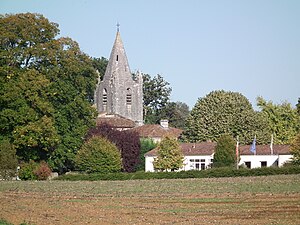Le Douhet
| Le Douhet | ||
|---|---|---|
|
|
||
| region | Nouvelle-Aquitaine | |
| Department | Charente-Maritime | |
| Arrondissement | Saintes | |
| Canton | Chaniers | |
| Community association | Saintes | |
| Coordinates | 45 ° 49 ′ N , 0 ° 34 ′ W | |
| height | 12-81 m | |
| surface | 18.35 km 2 | |
| Residents | 713 (January 1, 2017) | |
| Population density | 39 inhabitants / km 2 | |
| Post Code | 17100 | |
| INSEE code | 17143 | |
 Le Douhet - townscape with Saint-Martial church |
||
Le Douhet is a western French community with 713 inhabitants (at January 1, 2017) in the Charente-Maritime in the region Nouvelle-Aquitaine .
location
Le Douhet is about 50 meters above sea level. d. M. at a distance of about twelve kilometers (driving distance) northeast of Saintes in the middle of the cultural landscape of the Saintonge . The city of Cognac is about 32 kilometers to the southeast.
Population development
| year | 1968 | 1975 | 1982 | 1990 | 1999 | 2007 | 2016 |
| Residents | 502 | 477 | 518 | 589 | 636 | 700 | 708 |
The town's population has increased significantly since the end of the 1990s due to its proximity to Saintes and the construction of a new housing estate.
economy
Agriculture (grain and wine) still plays the major role in the economic life of the small community that is part of the Fins Bois wine-growing area in the Cognac region.
history
No specific information is published about the history of Le Douhet. However, the history of the place is likely to be closely linked to that of Saintes.
Attractions
See also: List of Monuments historiques in Le Douhet
- The parish church of Saint-Martial is - at first glance - a simple Romanesque building from the 12th century, the walls of which were stabilized in the 15th century by massive buttresses and a tower with a pointed stone spire and four corner pinnacles . On closer inspection, however, a rich architectural decor unfolds. The west facade is built on two levels: The lower level consists of the portal stepped back several times with - somewhat smaller - glare portals ( triumphal arch motif ). The left blind portal is cut by a corner buttress from the 15th century. The archivolt portal without a tympanum shows four angels on its inner arch, which are oriented towards an Agnus Dei in the middle. Two angels hold the mandorla , the other two waving censer. The two following arches are decorated with abstract, vegetable and braid-like motifs. In the outer arch there are apostles and evangelists . Johannes (beardless) and James the Elder Ä. (Pilgrim's staff) are easy to recognize. Almost the entire area of the gable field is taken up by three blind arcades , of which only the middle one has a large window. The single-aisled interior is covered by a pointed barrel vault with belt arch beams. The significantly smaller apse is separated from the nave by a choir arch , the lower part of which has been widened by removing the half-column templates . In the 18th century, a grisaille painting with rays, clouds, putti and a central triangle in which the four Hebrew letters יהוה ( YHWH ) - the so-called Tetragrammaton - are written, was attached to the ceiling of the apse dome as a symbol of the Trinity . A fresco from the late 15th century shows the martyrdom ( St. Andrew's Cross ) of an unknown bishop, who is watched by an equally unidentified Pope. The capitals of the church are carved with mythical creatures and vegetable motifs. The church was classified as a monument historique as early as 1915 .
- Le Douhet Castle, surrounded by a beautiful park, is a three-storey building with slightly protruding square corner pavilions from 1680, which Vauban may have been involved in planning . It was built for the local landlord ( Seigneur ) Rénaud de Pons. In addition to the park, the double balustrade-lined external staircase and the so-called lantern hall ( French salon de la lanterne ) are worth seeing . The castle is privately owned and was placed under protection as a Monument historique in 1969. The gardens have also been under monument protection since 1969.
- A little outside of the village you can see the tunnel-like and almost head-high Roman aqueduct from the 1st century AD, which once supplied the city of Saintes ( Mediolanum Santonum ) with fresh spring water. It is interesting to note that on both sides of the water-bearing canal, an elevated passage was left open so that the drinking water was not contaminated more than necessary when entering or cleaning the tunnel. The tunnel aqueduct was placed under protection as a monument historique as early as 1840.
literature
- Le Patrimoine des Communes de la Charente-Maritime. Flohic Editions, Volume 2, Paris 2002, ISBN 2-84234-129-5 , pp. 988-990.
- Thorsten Droste : Poitou. Western France between Poitiers and Angoulême - the Atlantic coast from the Loire to the Gironde. DuMont, Cologne 1999, ISBN 3-7701-4456-2 , pp. 204-205.
Web links
Individual evidence
- ↑ The Saint-Martial church in the Base Mérimée of the French Ministry of Culture (French)
- ^ The castle Le Douhet in the Base Mérimée of the French Ministry of Culture (French)
- ↑ Entry of the castle park in the Base Mérimée of the French Ministry of Culture (French)
- ↑ The aqueduct in the Base Mérimée of the French Ministry of Culture (French)

